Yes, Bike-Sharing Is Coming This Summer!
Mayor Barrett said not till 2015, but Midwest BikeShare promises 5-10 stations this summer.
On Monday, during a press conference at the end of the Mayor’s annual bike ride Mayor Barrett indicated that bike-sharing wouldn’t be rolling out in Milwaukee until 2015.
As Lee Corso is so fond of saying, not so fast.
Last year my colleague Jeramey Jannene reported that a system of at least 28 stations would rollout in 2014, it’s true that isn’t happening. But bike-share is coming to Milwaukee this summer on a smaller scale.
In a call to Urban Milwaukee this morning Kevin Hardman, launch director of Midwest BikeShare, Inc., explained that the city’s CMAQ grants won’t be used this year, but these are just a portion of the project’s total funds. “Using what we raised from TIF and private sources,” Hardman says, his group plans to create “between five and 10 stations on the ground this year.” As to when, Hardman says is should happen this summer. “We don’t have an exact date yet, but things are very much moving forward.”
Midwest BikeShare, Inc. and the City of Milwaukee are still trying to “qualify the sites,” for the first stations according to Hardman because when “citing these stations you don’t just drop them down.”
Last year Midwest BikeShare, Inc. worked with the city to install a pilot station at Discovery World to give the public an opportunity to test out the bikes and interact with the docking stations.
The first stations will be located near the central business district and “grow out from the Discovery World station…that’s good system design,” Hardman says.
Milwaukee’s Pilot Bike-sharing Station
Political Contributions Tracker
Displaying political contributions between people mentioned in this story. Learn more.
- March 29, 2016 - Tom Barrett received $100 from Kevin Hardman
Eyes on Milwaukee
-
Church, Cupid Partner On Affordable Housing
 Dec 4th, 2023 by Jeramey Jannene
Dec 4th, 2023 by Jeramey Jannene
-
Downtown Building Sells For Nearly Twice Its Assessed Value
 Nov 12th, 2023 by Jeramey Jannene
Nov 12th, 2023 by Jeramey Jannene
-
Immigration Office Moving To 310W Building
 Oct 25th, 2023 by Jeramey Jannene
Oct 25th, 2023 by Jeramey Jannene



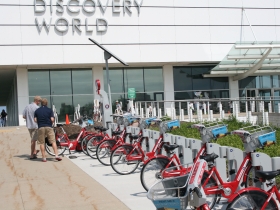
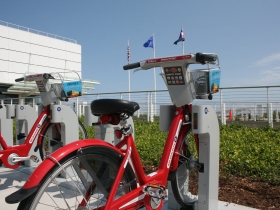
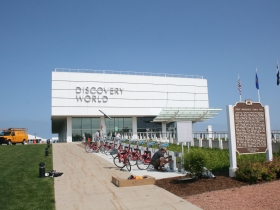
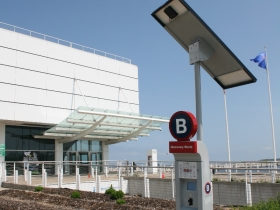
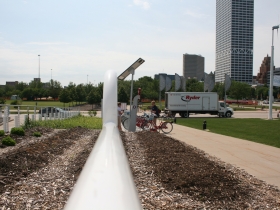
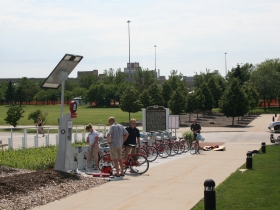

















[Hardman] adds that Milwaukee’s plan of rolling out a few stations a year and building up to a larger system is “no different than the vast majority of cities.”
That simply is not true. The vast majority of bike sharing operations – and unquestionably the most successful ones around the country – started with a relatively complete system of stations. They then expanded to other areas of the city and increased density of stations in the original area.
In order for a bike sharing system to both attract customers and also fund further expansion, it is important to have a useful system that serves at least the downtown. Station density (how many stations per square mile) has been shown to be a key indicator of how it will serve customers.
A few stations may attract tourists, but they will not demonstrate the strength of bike sharing as part of the larger transportation system. And demonstrating that bike sharing works for the city is key to getting the support and funding to further expand.
I urge the city to wait until it is ready to fully launch a useful number of stations. Otherwise, the program will be labeled as a cute oddity and not a real transportation option.
@Robbie: As a member of Midwest Bikeshare’s board of directors, I can say we wholeheartedly agree with your essential points. Our effort is predicated on carefully assessing the existing systems that have come before us, and – to the extent possible and applicable – using best practices. We also recognize that bikesharing in the United States is a transportation model in its relative infancy. As such, there is constant learning and innovation in every aspect of bikesharing- from the way capital and software work (or don’t), to the ways consumers choose to use systems and comfort with adoption.
Midwest Bikeshare is interested in sequencing our roll-out for a number of reasons. Some has to do with the practical realities of how soon funding is available and how soon bikes and stations can be produced. Some of it has to do with honoring financial commitments already made and leveraging momentum. Finally, there is the desire to learn more about system use, adoption and basic software and hardware mechanics, before scaling. We plan to continue a sequenced roll out to eventual scale at our desired density as soon as is possible. We think that’s both practical and smart. We’re confident that this scaling approach will help make Milwaukee’s system a real success.
A few biking stations in recreational areas is fine, as that’s where they will be appropriately used. In the city, bikes outside of pike paths and lanes tend to turn into nuisance vehicles, just as an ATV or scooter would be on an active road, or skateboards on a busy sidewalk. These kind of vehicles are not viable as primary modes of transportation and should not be expected to be in dense urban areas, especially given the climate. For the elderly who work, it certainly is not a very safe option in many cases either. Its smart not to go crazy spending and building a bunch of bikesharing operations all at once, trying to introduce a transportation system that is not ready to be embraced. Keep to the great network of trails and paths, and they will be appreciated.
I was just visiting Washington DC and took advantage of bike share for the first time. WOW! What a terrific experience. None of the hassles of figuring out where to lock up a bike, worry about it getting stolen or damaged, just the freedom of having rapid transportation without waiting for a bus/metro/cab or overpriced parking.
I look forward to bike share in Milwaukee!
@Juli,
Does Midwest Bikeshare intend to circulate a map of station locations soon?
Chris Jacobs said: “[Bicycles] are not viable as primary modes of transportation and should not be expected to be in dense urban areas, especially given the climate.”
Actually, bike sharing works great in dense urban areas, even in winter. NY City started its bike sharing program (“Citibike”) about 50 weeks ago and put stations exclusively in the densest parts of NYC (just Manhattan below 60th Street and close-in parts of Brooklyn) and it has been a huge success, even in winter.
NYC had an exceptionally harsh winter this year. February featured numerous “polar vortex” days and two large (at least 12-inch) snowfalls, yet even in February, there were 247,000 trips taken on Citibike.